Macaws of Brazil
Macaws belong to the same family as parrots, parakeets and cockatiels. They are characterized by having zygodactyl feet, i.e. feet with two toes pointing forward and two backward, and strong, curved beaks, perfect for opening fruits and breaking hard seeds. Macaws differ from other psittaciformes by having relatively large beaks, a bare or sparsely feathered face, and long tails1.
When we think of macaws, we think of the large scarlet or hyacinth macaws that have always enchanted us with their exuberance. However, there are actually about 18 species of macaws found from Mexico to Paraguay. Brazil has the greatest diversity, with 12 species in six genera: Anodorhynchus, Cyanopsitta, Ara, Primolius, Diopsittaca and Orthopsittaca.
1 - Blue macaws (Anodorhynchus ssp.)
There used to be three species of blue macaw, but one of them, the glaucous macaw (A. glaucus), is officially extinct in Brazil, having not been sighted for more than 80 years. The two existing species are the Hyacinth Macaw and the Lears’s Macaw. Both are very similar: they are blue with black inner wings and tail, and the outline of the eyes and the skin around the beak is yellow.
However, the yellow band around the Hyacinth Macaw is thinner than that of the Lear’s macaw. The Lear’s macaw is also smaller than the Hyacinth Macaw and has a greenish shine on its head feathers2.
Hyacinth Macaw (A. hyacinthinus): The Hyacinth Macaw is the largest flying psittacid in the world, reaching up to 1 meter (3 feet) in length (from head to tail tip) and 1.20 meters (4 feet) in wingspan. Native to South America, it is mainly found in Brazil, with some sightings in regions bordering the Pantanal wetlands of Bolivia and Paraguay. Of the 6,500 individuals estimated in 2003, about 5,000 are in the Pantanal and about 200 in Bolivia.
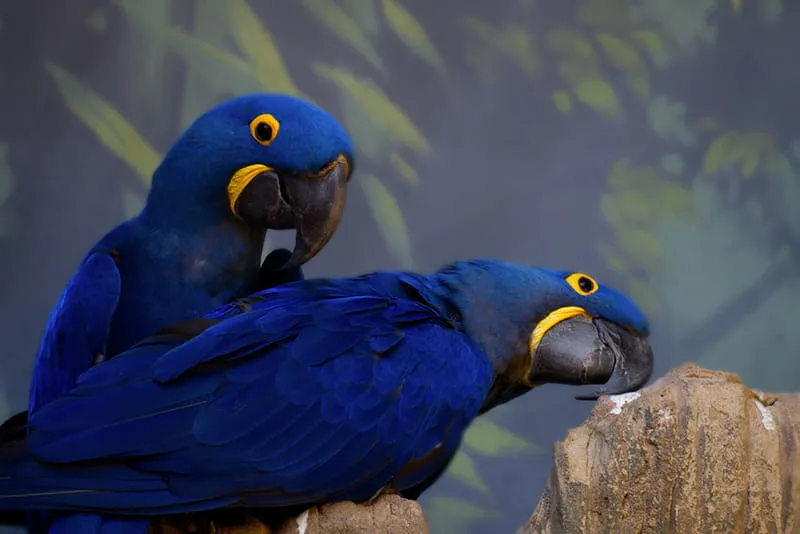
They feed on the seeds of various palm trees. They are monogamous and spend their entire lives with the same partner. They take turns building the nest and taking care of the chicks, separating only when one of them dies. Even then, they do not seek out new mates and do not reproduce again.
During the 1980s, the species suffered a severe decline after about 10,000 birds were illegally captured for the pet trade. Combined with habitat destruction and hunting, the Hyacinth Macaw was considered vulnerable to extinction by 2018 on the Red List of Threatened Brazilian Fauna3.
Currently, their numbers have increased thanks to the efforts of conservation projects, but they have not fully recovered and their situation is still fragile due to low birth rates and the capture of their eggs and chicks for trade4.
Lear’s macaw (A. leari): It is an endemic macaw found only in the Raso da Catarina Ecological Reserve and the Canudos Biological Reserve - north of the state of Bahia. It differs from the Hyacinth Macaw mainly by the greater amount of exposed yellow skin on the lower jaw, by the presence of greenish feathers on the head and neck region, and by its small size - about 70 cm5.
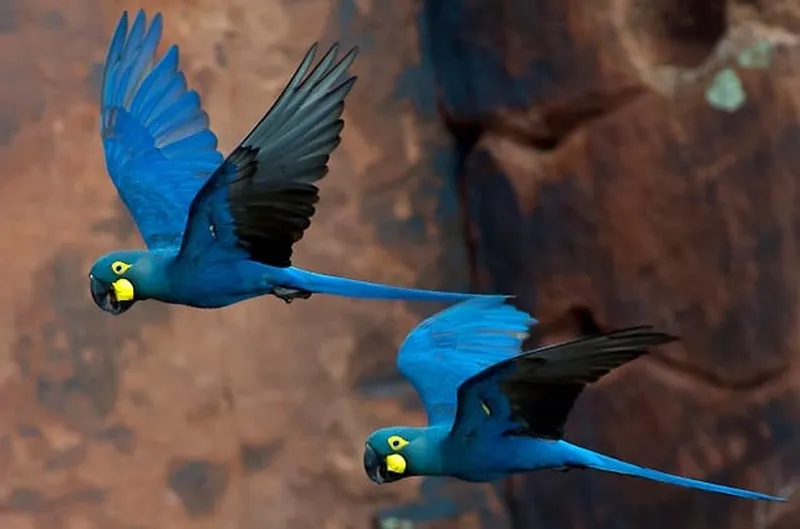
This species feeds almost exclusively on the fruits of the licuri (a type of palm tree), and a single individual can eat more than 300 fruits a day. Thus, deforestation for cattle ranching and agriculture reduces its food resources and consequently the survival of the species. Another aggravating factor in its conservation status is the hunting and trafficking of animals, which, although reduced compared to previous years, still exists.
It is estimated that in the 90s there were no more than 60 individuals6, but thanks to several environmental conservation programs their numbers have gradually increased and since 2008 they have left the category “critically endangered” and are currently classified as “endangered”.
Although they are still few, there are currently about 2,000 individuals, but only 20% 3 6 of this number are adults that can reproduce. It is expected that with continued conservation efforts, their numbers will continue to increase over the years.
2- Spix’s macaw (Cyanopsitta spixii)
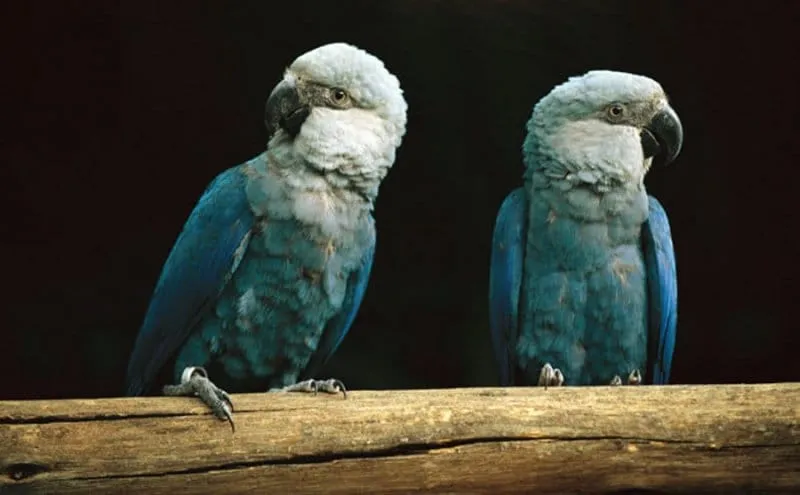
It is the only species of its genus. The Spix’s macaw averages 57 cm in length and has light blue plumage with a light gray head. Its habitat is gallery forests in the extreme north of Bahia, south of the São Francisco River.
The Spix’s Macaw was declared extinct in the wild in 2000 due to habitat destruction and capture for the pet trade. However, since the 1990s, the Brazilian government has been working on a project to breed captive Spix’s macaws and reintroduce them to the wild.
In 2020, thanks to the efforts of the German organization ACTP and ICMBio, 52 captive-born Spix’s macaws were brought from Germany to Brazil. These macaws went through a long and careful process of adaptation to the wild, and those that performed best in the tests were the first to be reintroduced into the wild in 2023.
The reintroduced Spix’s macaws are being closely monitored and it is hoped that these individuals will thrive so that more macaws can be released into the wild - and once again dominate their habitat7.
3 – Macaws (Ara ssp.)
The Scarlet Macaw and the Blue and Yellow Macaw belong to the genus Ara. They are known for their colorful plumage, with shades of blue, yellow, red and green. There are currently 8 species of macaws in this genus. In Brazil, there are 4 species found from the north to the southeast, but it is in the Cerrado and Amazon rainforests that their numbers are greatest.
Ara macaws can mate with members of other species, producing fertile hybrids with unique colors. They can also breed with the blue macaws of the Anodorhynchus genus, but the descendants will be sterile hybrids.
Although beautiful and coveted by macaw breeders, the occurrence of hybridism in nature may indicate a certain imbalance in the species, and it is still unclear what effects it may have.8 9 10.
Chestnut-fronted macaw (A. severus): One of the least known macaws in Brazil, it occurs in most parts of the Amazon rainforest, both inside and outside of Brazil11. It is the only predominantly green colored macaw in the country. It has a brown forehead and the top of its head is blue, its back, belly, and part of its wings are green, and its flight feathers are blue.
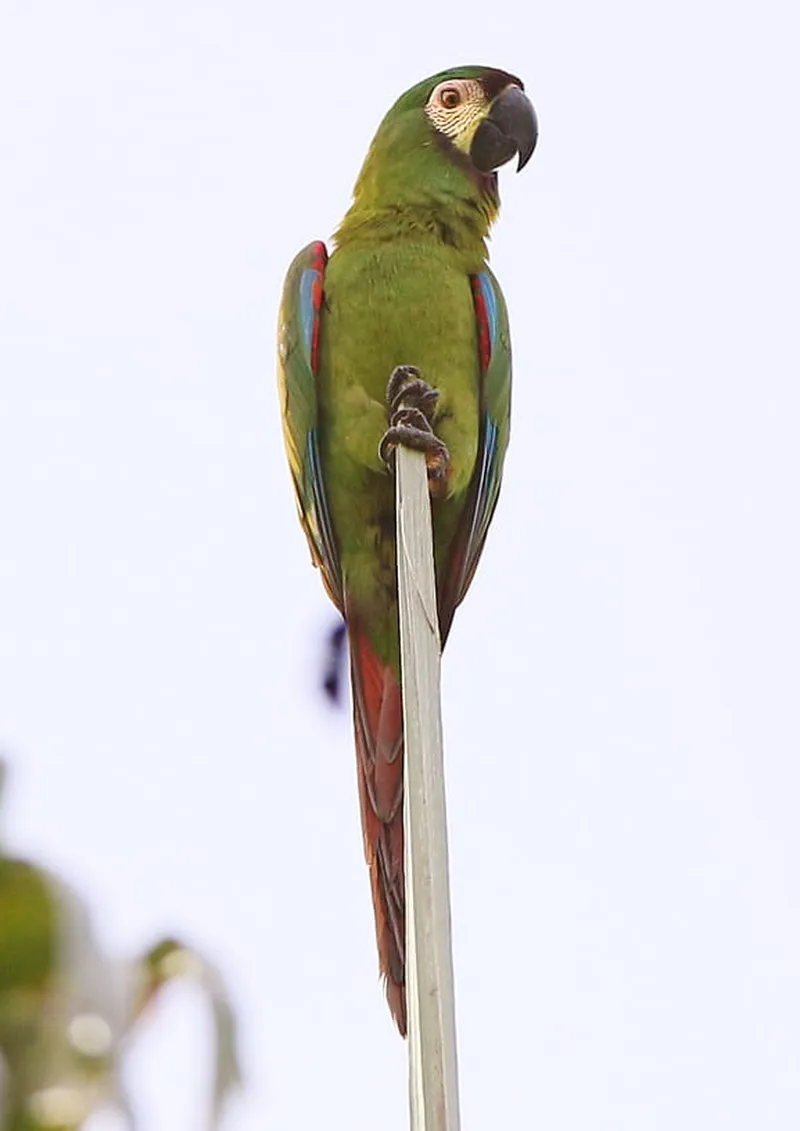
The inside of the wings and tail is red and black. Like other macaws of the genus, it has practically no feathers on its face, leaving its white skin exposed. It is about 45 cm (1.5 feet) long, half of which is the tail.
Although its numbers are declining, the chestnut-fronted macaw is a very common and widespread species, so it is not in danger of extinction.
Blue-and-yellow macaw (A. ararauna): It measures about 80 cm (2.6 ft). It has a blue upper body and yellow underparts, a green top of the head and black feathers just below the jaw. It also has a line of small black feathers on its bare face.
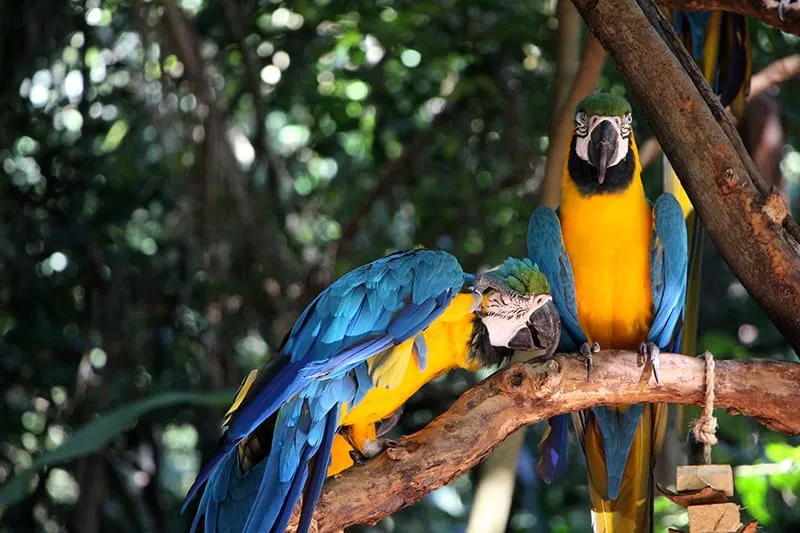
It is found in Colombia, Peru, Venezuela, Bolivia, Paraguay and Ecuador. In Brazil, it is found mainly in the north and central-west regions, but there are reports of occurrences in the south-east. Although nearly extinct in some countries, the blue and yellow macaw is not currently endangered in Brazil, but its population is declining due to habitat destruction and wildlife trafficking12.
Scarlet macaw (A. macao): It is the most famous species in the world for its great beauty. They can grow up to 90 cm (3 ft). Its plumage is predominantly red, its wings have blue and yellow feathers with green tips on the outside and the inside of the wings are mainly yellowish. It has a light upper bill and a black lower bill.
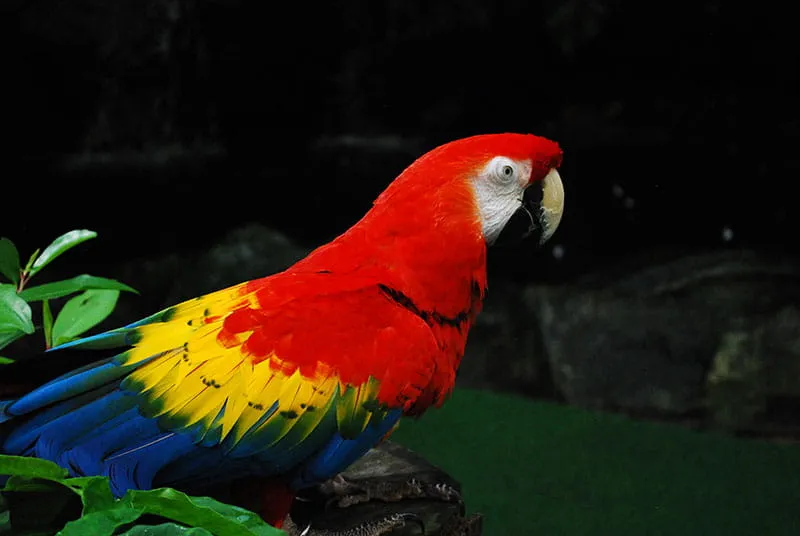
It occurs in much of the Amazon rainforest and in some regions of Mexico and Central America. The species is not considered endangered in Brazil, but its numbers are in constant decline13 and efforts to reverse the situation have not yet yielded results.
Red-and-green macaw (A. chloropterus): It is also known as the green-winged macaw. It is about 95 cm (3.10 ft) long. It is very similar to the Scarlet Macaw, but differs in having small red feathers on a bare white face. Also, the feathers on the upper part of the wings are green instead of yellow, and the inner part is red.
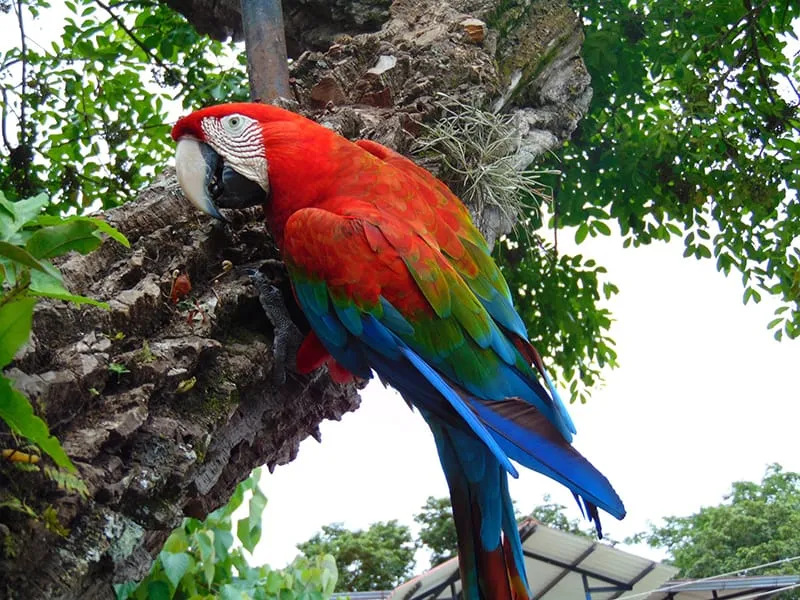
Red-and-green macaw is found throughout the Amazon rainforest, the Pantanal and part of the Cerrado. It is not threatened with extinction, but trade and habitat destruction can rapidly reduce its numbers if left unchecked.
4 – Primolius macaws (Primolius ssp.)
They are very small macaws, less than 50 cm (1.6 ft) long - sometimes called mini macaws. They are relatively similar to each other, having a predominantly green body with the outer part of the wings blue and the inner part yellowish. However, each species can be distinguished by some details in their plumage. There are 3 species spread over most of Brazil:
Golden-collared macaw (P. auricollis): It is about 40 cm (1.3 ft) long. It has a black forehead and throat. The back of its neck is marked with yellow feathers, resembling a golden necklace.
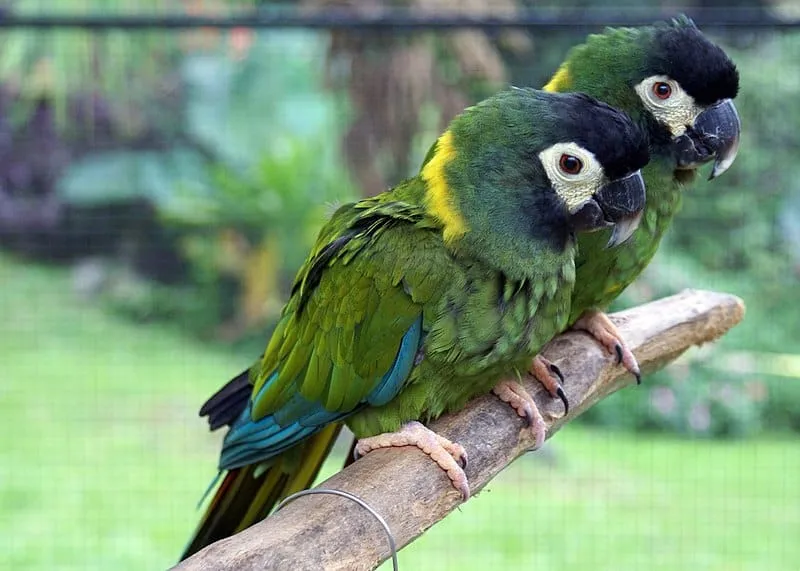
This species is native to the central region of South America. In Brazil, it is found in southern Rondônia, Mato Grosso and Mato Grosso do Sul. A second, disjunct population occurs in the extreme northeast of Mato Grosso, as far southwest as Pará and western Tocantins.
It is a very adaptable bird and, unlike the other macaws, it is not as affected by environmental factors. It is therefore not considered endangered.
Blue-headed macaw, (P. couloni): This macaw has a blue head, flight feathers, and tail tip. The bare skin of its face contrasts with other species and genera in that it is the only one with a black face.
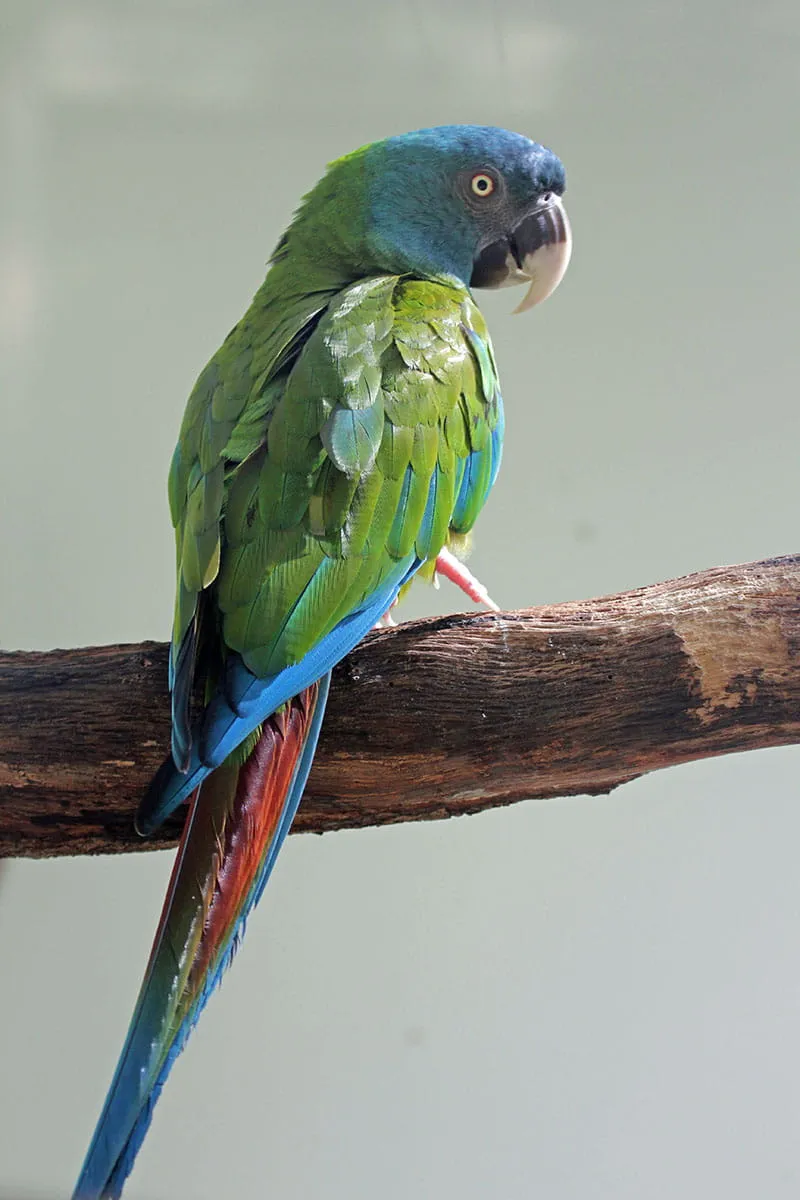
This species inhabits only a small part of Acre, in addition to Peru and northwestern Bolivia. Its population, already reduced by low birth rates, has suffered from trafficking and has decreased its numbers even more, leading the animal to be classified as a species vulnerable to extinction14.
Blue-winged macaw (P. maracana): APresents red coloration on the forehead, lower belly, and back. The skin of its face is white around the eyes and yellowish near the lower bill. It is about 40 cm (1.3 ft) long.
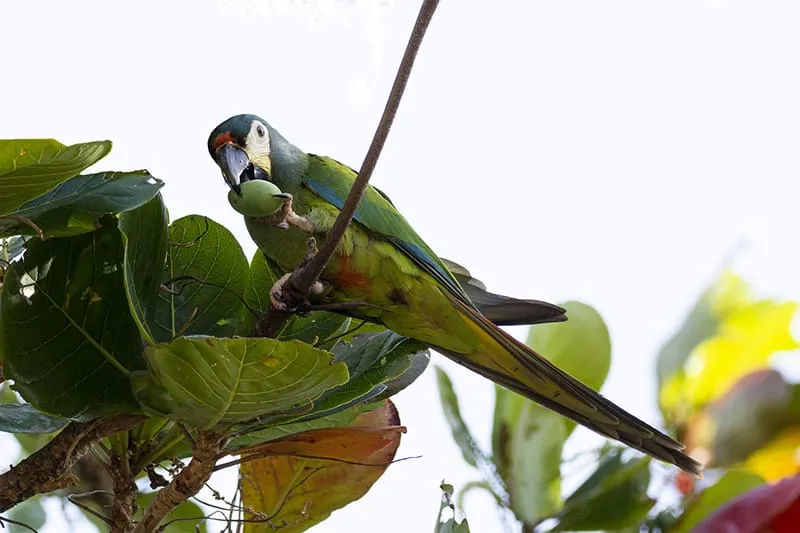
It is found in almost all of Brazil, with the exception of the Pampas and the Amazon Rainforest. Although it is still a very common and widespread species, it is probably extinct in some regions and its population is declining rapidly throughout its range due to trade and habitat loss, so it is classified as Near Threatened15.
5 - Red-shouldered macaw (Diopsittaca nobilis)
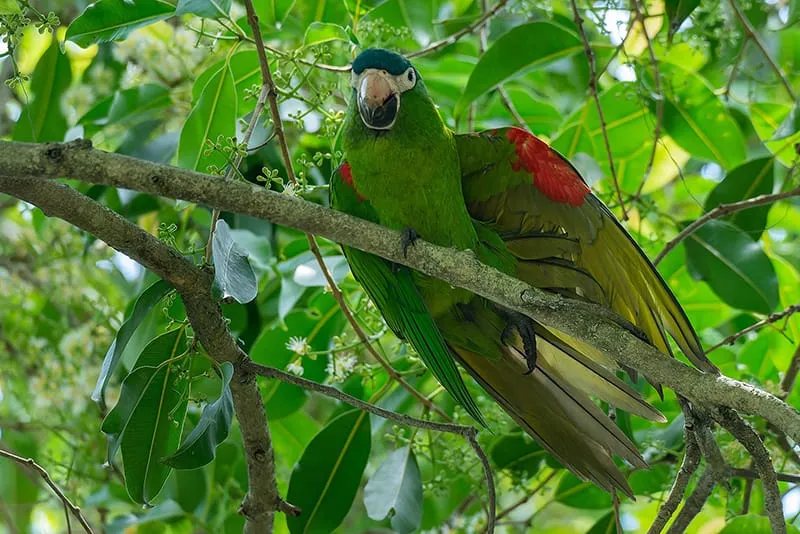
The Red-shouldered macaw is the smallest macaw species, only about 33 cm long (no larger than a cockatiel). They are very similar to the blue-winged macaw , but they are smaller and have the red coloration only in the region of the alulas or ridge. In addition, the upper bill of the noble maracanã is light and the lower bill is dark.
They live mainly in the Cerrado, but are also found in parts of the Caatinga in Alagoas, Pernambuco and Paraíba, and in the Atlantic Forest of São Paulo and Rio de Janeiro. This species has a large population size, and although it is declining due to habitat loss, it is not currently threatened with extinction.
6 - Red-bellied macaw (Orthopsittaca manilata)
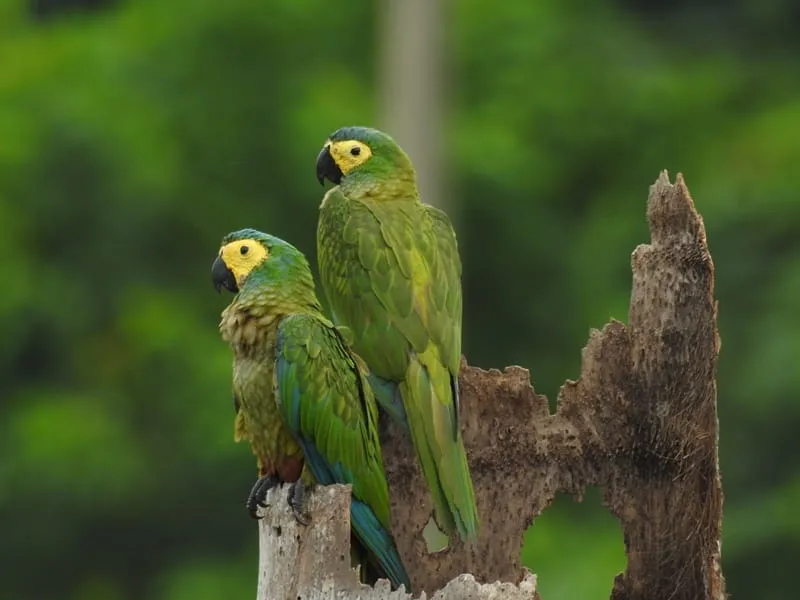
It measures about 45 cm (1.5 ft). It has a blue head and, as its name suggests, yellow skin on its face. It has various shades of green on its body, most pronounced on its back, and a grayish green on its chest. It also has a red patch on the underside of its belly.
It is found in parts of the Cerrado and throughout the Amazon rainforest. Due to its large geographic range, it is not considered endangered. Their diet consists almost exclusively of the fruits and seeds of the Buriti Palm and the Imperial Palm (Roystonea oleracea), so the preservation of their feeding grounds is essential to keep these birds out of danger16.
Captive breeding
Currently, it is not illegal to have a macaw as a pet in Brazil if the animal is purchased from one of Ibama’s authorized captive breeding centers. Captive breeding centers breed the bird in captivity without interfering with wild individuals - improving their docile nature, making them healthier, and helping to maintain wild populations. The problem is that, depending on the species, a legalized macaw can cost exorbitant prices.
Because of this, many people choose trafficked and cheaper birds, but this may not be healthy for humans, as wild birds can carry diseases. It is definitely not healthy for the bird as it will become sick, stressed, depressed and die young.
Furthermore, by capturing animals like macaws, which play an important biological role in nature, we are driving the species closer to extinction and harming the entire ecosystem to which they are connected. A good example of this is by preventing the reforestation and growth of the native trees on which they feed.
These trees, which are not planted because the macaws do not open and drop their fruit, will no longer serve as shelter and food for many other animals, making it difficult for them to survive. However, if you want to have a legal, healthy, tame, captive-bred macaw, you must remember that the larger the animal, the more space you need to raise it.
The largest macaws, for example, need real enclosures that are at least 15 meters (49 ft) long to have enough space for their daily activities17. Their diet must also be carefully monitored, as they are not birds that can eat any seed, like sparrows and canaries.
Although the smaller species are cheaper and require less space, they are still wild birds that need a lot of interaction and daily activities. They are also very communicative and have chewing habits that can become destructive when the bird is stressed or bored.
Macaws are wonderful birds that many of us dream of seeing or having around us, but this desire becomes contradictory when we need to take them out of the wild and confine them indoors for our own personal satisfaction. Raising a wild bird may not be an easy task. Although beautiful, these birds are very active and can live up to 50 years depending on the species.
References:
-
Livro Vermelho da Fauna Brasileira Ameaçada de Extinção volume III – Aves - 2018 ↩︎
-
Planeta aves - Reintrodução das ararinhas-azuis na natureza! Aves retornam à caatinga bahiana ↩︎
-
Campo Grande News - Canindé com vermelha cria a arara híbrida e “nova espécie” já preocupa ↩︎
-
Jordan, R. (2009). Guacamayos. Una guía completa. Espanha: Editorial Hispano Europea, S.A.. ↩︎
-
Araras híbridas são flagradas disputando ninho com canindé ↩︎
-
The Online Guide to the Animals of Trinidad and Tobago - Orthopsittaca manilata ↩︎
